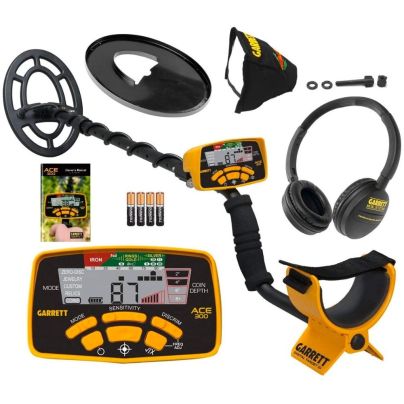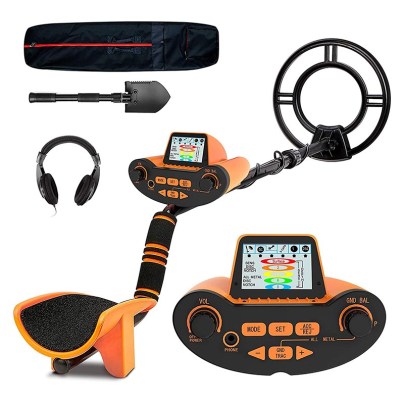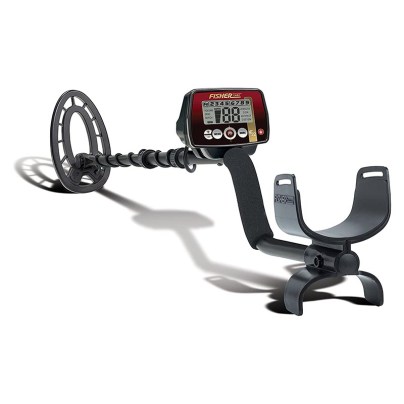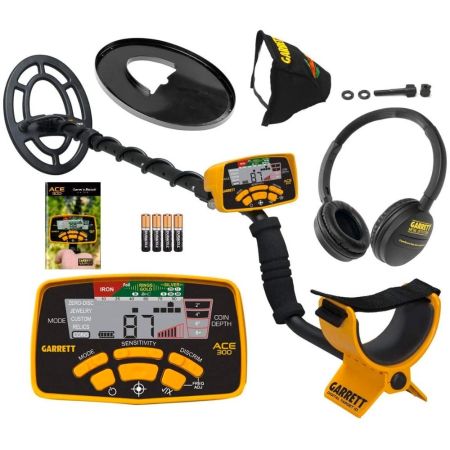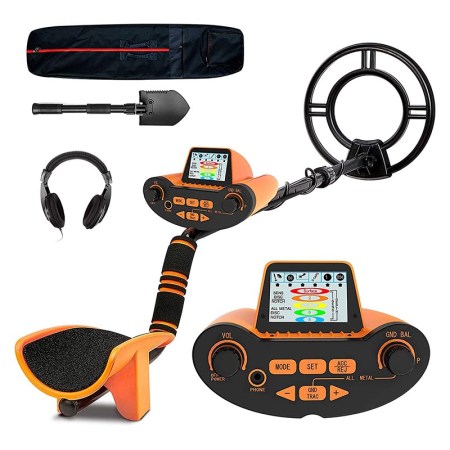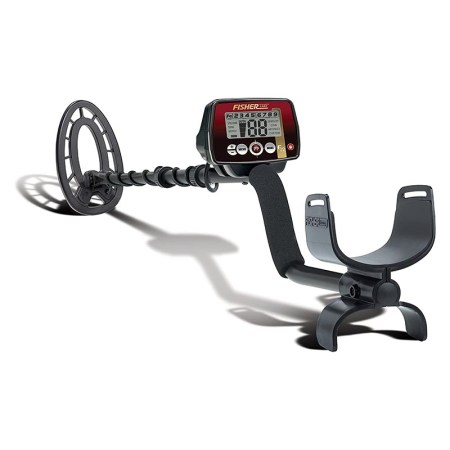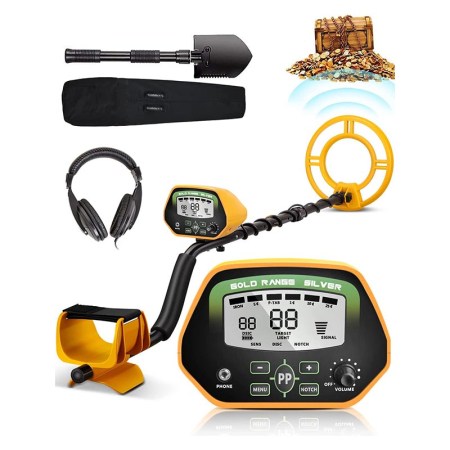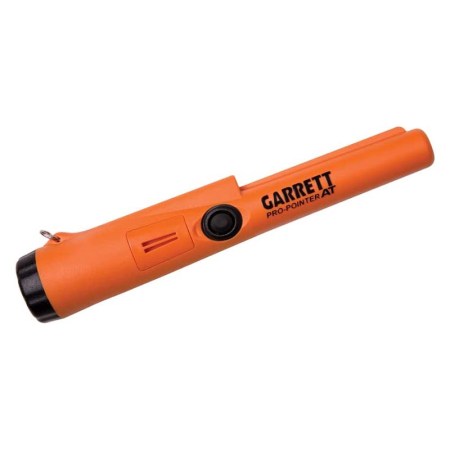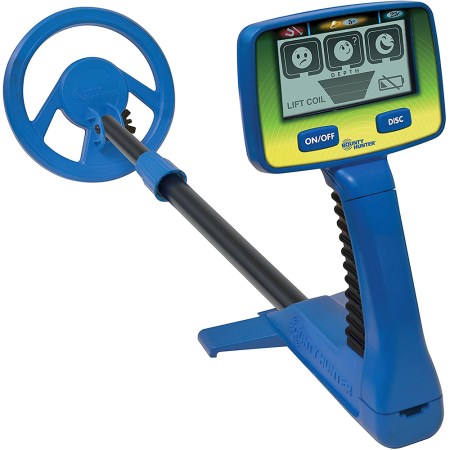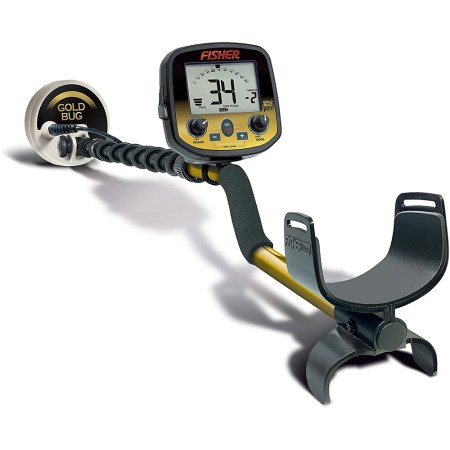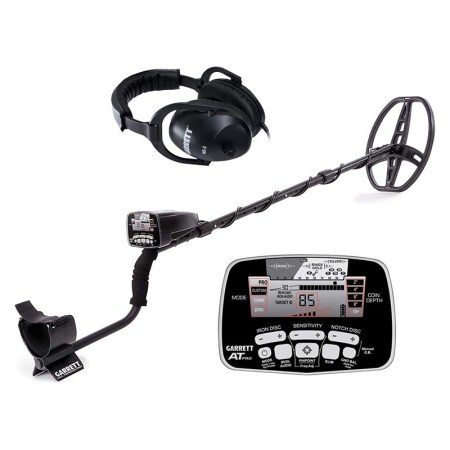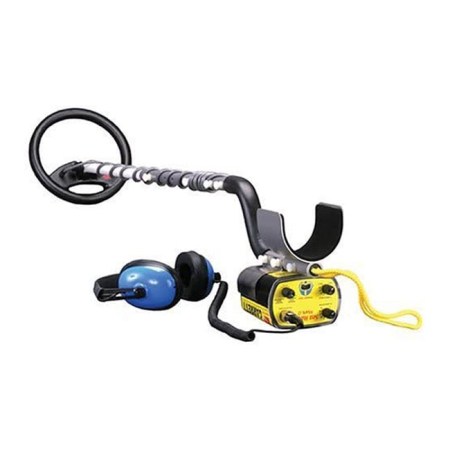We may earn revenue from the products available on this page and participate in affiliate programs. Learn More ›
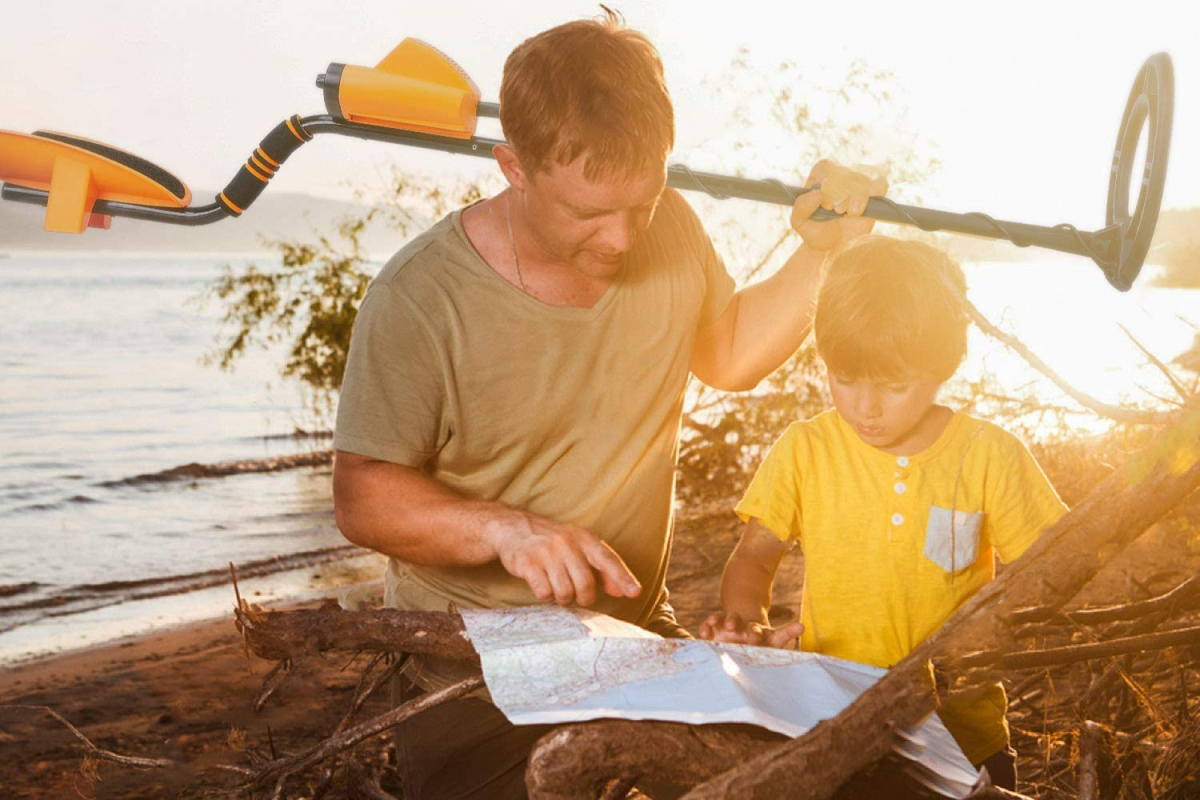
Metal detectors are devices designed to find metal buried under dirt, sand, grass, and even in bodies of water. Metal detectors work by creating a magnetic field around the electrical search coil, which spreads out to an average depth of about 10 inches. If conductive material is within the detector’s range, the electromagnetic signature of the material disrupts the magnetic field. The detector’s visual and audio alerts let you know you have found something.
Metal detecting is a great hobby or camping activity for individuals or for families with children—some dedicated and skilled practitioners even pursue it as a professional career. The best metal detector for you will depend on how and where you want to use it, and whether you want a simple, straightforward model or one with lots of bells and whistles.
The products below were selected as the best metal detectors in their respective categories, based on customer satisfaction, product efficacy, and overall value. We did in-depth research into the specifications, features, and customer reviews of each metal detector to create the list of top picks.
- BEST OVERALL: Garrett ACE 300 Metal Detector With Waterproof Coil
- BEST BANG FOR THE BUCK: Sunpow Professional Metal Detector for Adults
- BEST FOR BEGINNERS: Fisher F22 Weatherproof Metal Detector
- BEST FOR DEPTH: Bounty Hunter Tracker IV Metal Detector
- BEST RELIC HUNTING: RM Ricomax Professional GC-1037 Metal Detector
- BEST WATERPROOF: Garrett Pro-Pointer AT Waterproof Pinpointing
- BEST FOR KIDS: Bounty Hunter Junior T.I.D. Metal Detector
- BEST FOR GOLD: Fisher Gold Bug Pro Metal Detector
- BEST FOR FRESHWATER: Garrett AT Pro Metal Detector
- BEST FOR SALT WATER: Garrett Sea Hunter Mark II Waterproof Metal Detector
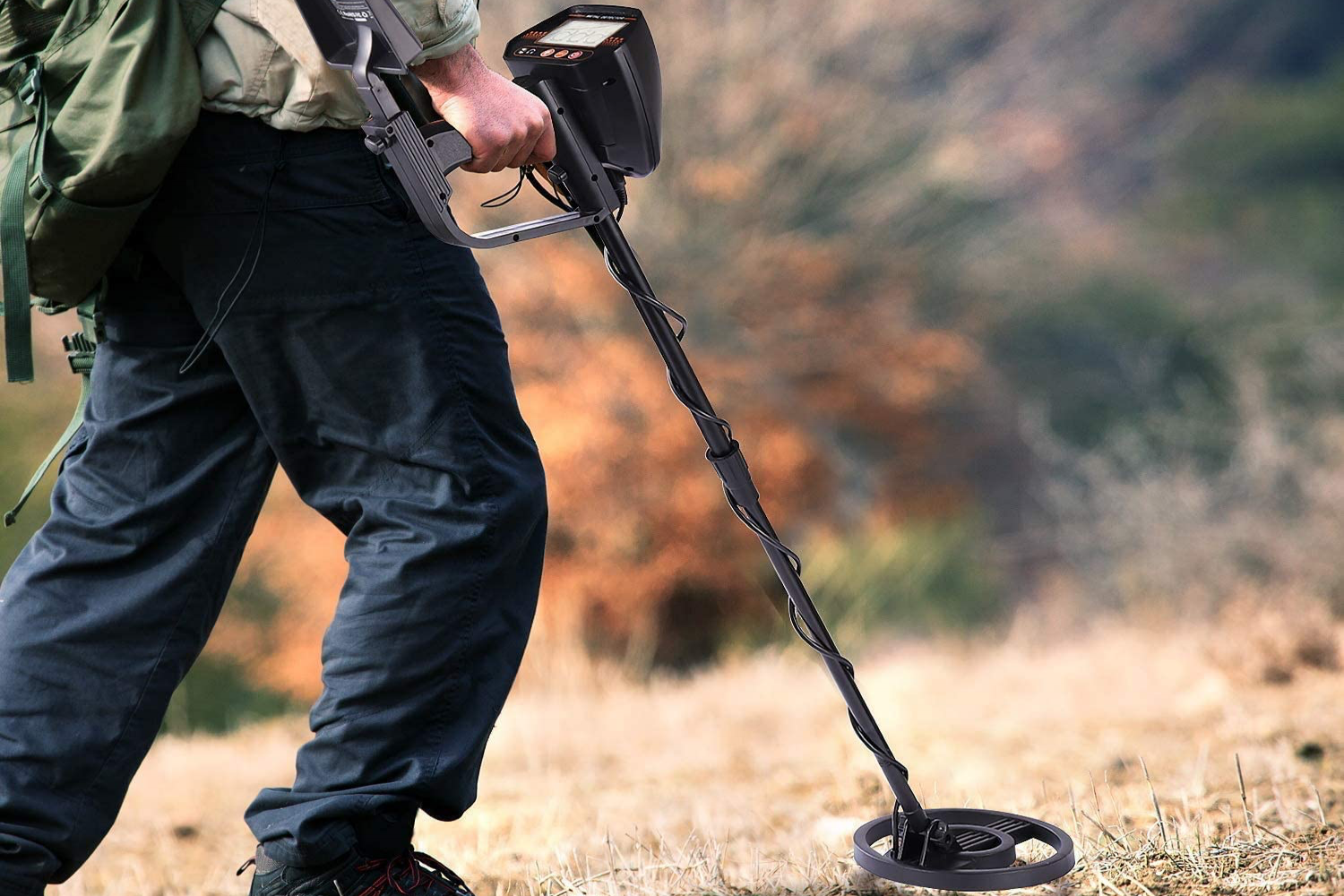
How We Chose the Best Metal Detectors
We researched the best metal detectors in a variety of categories and chose options with high customer satisfaction for professionals, enthusiasts, or as a gift for your favorite camper. The list factors in the type of metal detector, weight, maximum search depth, operating and search modes, special features, and accessories included by the top brands.
VLF (very low frequency)and waterproof metal detectors were among the most popular options, and the list focuses on these types with one PI (pulse induction) detector included (more information on the various types is included near the bottom). We focused on lightweight units that are easy to handle, each weighing between 6.3 ounces and 6.84 pounds. Many metal detectors that were chosen have maximum search depths between 3 to 8.7 inches and target a variety of metals. The list prioritizes models with all-metal and discrimination modes, frequency and sensitivity adjustment, and target depth indicators. We also chose metal detectors that come with accessories such as headphones and a shovel.
Our Top Picks
These top-rated metal detectors were chosen based on quality, price, and customer satisfaction. Each model was vetted thoroughly and its features are described in detail.
Best Overall
Garrett ACE 300 Metal Detector With Waterproof Coil
See ItThe Garrett ACE 300 metal detector has a maximum search depth of 8 inches and a frequency adjustment dial that makes it easy to clear up static and other signal interference. The VLF metal detector has adjustable discrimination sensitivity, giving the user a high degree of control over the type of metal he or she detects.
This metal detector is lightweight at 2.9 pounds, and has a padded, ergonomic grip to reduce hand and arm fatigue. It is packaged with a set of headphones that can be used in loud environments, like crowded beaches. The detector’s pinpointing mode gives off increasingly strong signals as you get closer to the object you have detected, and its target depth indicator gives you the estimated depth of the object. Plus, the waterproof coil is perfect for detecting metals in water or moist areas.
Product Specs
- Type: VLF detector
- Weight: 2.9 pounds
- Maximum search depth: 8.5 inches
Pros
- The frequency adjustment dial prevents any kind of signal interference
- Adjustable discrimination sensitivity helps user to better find desired materials
- Pinpointing mode and target depth indicator narrows down search area
- Padded, ergonomic grip makes it easy to hold for long periods of time
- Includes a set of headphones for advanced hearing and detection
Cons
- Some users say they encountered manufacturing defects with this metal detector
Get the Garrett ACE 300 metal detector at Amazon or The Home Depot.
Best Bang for the Buck
Sunpow Professional Metal Detector for Adults
See ItWith this metal detector you can head down to the beach or the river and get a little wet because it is waterproof. The Sunpow professional metal detector weighs 6.78 pounds and has an adjustable stem. Though it’s a little heavy, being able to adjust it to the correct length is a plus. The Sunpow comes with a carrying bag and a metal shovel, which will help you dig up your treasures.
The metal detector has a maximum search depth of 8.7 inches and it has three search modes, including all-metal, notch, and discrimination mode. All-metal mode will detect all metals in the area including iron, aluminum, gold, bronze, and silver, without filtering at all. Notch mode allows the user to ignore undesirable metals so you can focus on your intended targets.
Discrimination mode lets you choose the type of metal object you want for metal detecting and ignore all other metals. This metal detector also has a manual ground balance adjustment function, so you can decide what is included in your search and what is not.
Product Specs
- Type: Unspecified
- Weight: 6.78 pounds
- Maximum search depth: 8.7 inches
Pros
- Waterproof; suitable for use in ravines, rivers, and on beaches
- Metal detector’s adjustable stem can be retracted or extended as needed
- All-metal, notch, and discrimination search modes included with this device
- Includes a carrying bag, shovel, and headphones for ease of use and portability
- Manual ground-balance adjustment can be calibrated for different environments
Cons
- Some users report ineffectual use or difficulty using certain features
Get the Sunpow professional metal detector at Amazon.
Best for Beginners
Fisher F22 Weatherproof Metal Detector
See ItFor those who haven’t used a metal detector before, the Fisher F22 Weatherproof Metal Detector is all-purpose and easy to use for both adults and children. Suitable for searching for precious metals, coins, artifacts, and more, this detector’s weatherproof construction can withstand inclement weather for searching beaches, forests, and other outdoor areas.
This excellent metal detector has a hand grip and arm cup and weighs just 2.3 pounds, so carrying it for long periods should not be an issue. Though this pick is not the cheapest metal detector, it comes with some high-tech features including an easy-to-read screen with push-button controls for quick discrimination, sensitivity, notch, and pinpoint adjustments while metal detecting.
Product Specs
- Type: VLF detector
- Weight: 2.3 pounds
- Maximum search depth: 9 inches
Pros
- All-purpose detection; capable of detecting multiple object and metal types
- Sturdy, weatherproof construction; this metal detector can withstand heavy-duty use
- Hand grip and arm cup makes holding the detector easier;
- Easy-to-read screen and push-button controls
Cons
- Not meant for deep-water submersion or overly wet conditions
- Pricey compared to similar metal detectors available on the market
Get the Fisher F22 metal detector at Amazon or MetalDetector.com.
Best for Depth
Bounty Hunter Tracker IV Metal Detector
See ItThere’s no reason novice metal-detector users have to spend a lot of money on equipment for their new hobby. The Bounty Hunter Tracker IV metal detector is a great entry-level metal detector that won’t empty any wallet. It has a preset ground balance and comes with a large carrying bag for easy transport.
Weighing 2.8 pounds, the Bounty Hunter Tracker IV is a lightweight option with a maximum search depth of 7 inches. Its dials allow the user to select the target metal and adjust the sensitivity of the signal. When the metal detector is In all-metal mode, a user can detect all conductive metals in a given area. This product does not have a pinpoint function, however, so it may be difficult to narrow down the exact location of any metals found during metal detecting.
Product Specs
- Type: Unspecified
- Weight: 2.8 pounds
- Maximum search depth: 7 inches
Pros
- Cheap metal detector compared to similar options on the market
- Preset ground balance for user-friendliness; adjustable target sensitivity for finding different metal and object types
- Comes with convenient, large carrying bag that makes transporting and storage easy
Cons
- No pinpoint function; may be hard to narrow down search area
Get the Bounty Hunter Tracker IV metal detector at Amazon or The Home Depot.
Best Relic Hunting
RM Ricomax Professional GC-1037 Metal Detector
See ItWhile the RM Ricomax professional GC-1037 metal detector has a discrimination mode, relic hunters will especially appreciate its all-metal and pinpoint modes. When looking for potentially ambiguous relics that may get bypassed by an automated discrimination system, it’s best not to let the metal detector decide what is valuable and what isn’t.
The RM Ricomax detector is fully submersible, weighs just 2.31 pounds, and has an ergonomic forearm grip to reduce fatigue over long periods of use. This metal detector has a maximum search depth of 10 inches and a large LCD display with visual indicators for target identification, discrimination mode, and sensitivity adjustment. Two 9-volt batteries are required and included for the unit.
Product Specs
- Type: Unspecified
- Weight: 2.31 pounds
- Maximum search depth: 10 inches
Pros
- All-metal, pinpoint, and discrimination modes for finding certain objects and metals
- Submersible; suitable for use in rivers, ravines, and on beaches
- Sensitivity adjustment via LCD display can help find specific items
- Ergonomic forearm grip makes it easy to carry this device for more than an hour
- Includes a shovel and a pair of headphones for added user-friendliness
Cons
- Limited search depth compared to similar models available on the market
Get the RM Ricomax GC-1037 metal detector at Amazon.
Best Waterproof
Garrett Pro-Pointer AT Waterproof Pinpointing
See ItLong-handled metal detectors can be difficult to maneuver when you’re swimming with them. Metal hunters who search the shallows of rivers, lakes, and ocean will want to consider the Garrett Pro-Pointer AT Metal Detector, which is just 9 inches long and weighs 6.5 ounces. This model can withstand being submerged in up to 10 feet of water, and its bright orange outer shell is easy to spot if you lose it in the murky depths.
Another terrific feature of the Garrett Pro-Pointer is that it has a locator alarm that will sound if you lose it. The sound is automatically activated after 5 minutes if the user doesn’t press a button on the detector during that time. With this VLF metal detector you can scan to a depth of 4 inches, using one of three different sensitivity settings. Its pinpointing tip, scraping blade, and LED light will help you locate objects buried in soft sands and murky waters.
Product Specs
- Type: Waterproof VLF detector
- Weight: 6.5 ounces
- Maximum search depth: 4 inches
Pros
- Waterproof down to 10 feet; suitable for looking for submerged items
- Locator alarm allows users to pinpoint metal and objects easily
- 3 sensitivity settings for different metal types; LED light helps locate objects in dark spaces
Cons
- Limited search depth compared to other metal detectors on the market
Get the Garrett Pro-Pointer AT metal detector at Amazon, Bass Pro Shops, or Kellyco.
Best for Kids
Bounty Hunter Junior T.I.D. Metal Detector
See ItPick up your child’s first metal detector to help get them involved in something you enjoy, or to start a new activity together. The Bounty Hunter Junior T.I.D. metal detector has an attractive exterior designed for kids, but it functions like an adult product. Weighing just 1.5 pounds, this VLF metal detector is lightweight and has an adjustable handle that makes it easy for kids to carry and use.
This junior metal detector has a max search depth of 6 inches and an adjustable discrimination control that allows the user to exclude specific materials from a search. One of its coolest features is that it has three audio tones and three visual indicators that notify you when it detects an object, and it will even reveal in general terms what the object is. The Bounty Hunter Junior metal detector’s target depth indicator will also let kids know how deep they will need to dig for their treasures. Stick to dry locations when using this model, however. It is not waterproof and may be susceptible to water damage in shallow water and light rain.
Product Specs
- Type: VLF detector
- Weight: 1.5 pounds
- Maximum search depth: 6 inches
Pros
- Adjustable length; arm can be lengthened or retracted by the user
- 3-target audio system; allows users to hear when different metals are located
- Visual notification system for narrowing down a given search area
- Adjustable discrimination control helps in tracking certain metals and objects
Cons
- Limited search depth compared to similar metal detectors for children
- Must stick to dry areas when using; limited weatherproofing in the construction
Get the Bounty Hunter Junior T.I.D. metal detector at Amazon.
Best for Gold
Fisher Gold Bug Pro Metal Detector
See ItThe Fisher Gold Bug Pro Metal Detector has many beneficial features to detect and identify gold. The VLF metal detector uses a continuous ground-condition sensor system that provides updated readouts whenever the metal detector is moved to a new location. As you’re interpreting the readouts on the display, the metal detector automatically adjusts the ground balance system so that the next wave of the wand is optimized to your new location.
This metal detector also has a high maximum operating frequency optimal for detecting gold and very small materials and, at just 2.5 pounds, it is easy to carry for long periods of time. It has the bells and whistles hobbyists want, including a discrimination mode, an all-metal mode, and a pinpoint mode with depth indicator. The Fisher Gold Bug Pro’s max search depth is 6 inches and it will alert users with its tone and visual ID systems when it detects a metallic item. While this metal detector is designed to find gold, it can also be used for finding other materials.
Product Specs
- Type: VCO
- Weight: 2.5 pounds
- Maximum search depth: 6 to 8 inches
Pros
- Versatile search features that includes a continuous ground-condition sensor system
- Detects gold and small materials easily; depth indicator is included
- Discrimination, all-metal, and pinpoint modes included for narrowing search area
- Visual and audio alerts help a user find objects quickly
Cons
- Limited search depth compared to other metal detectors on the market
Get the Fisher Gold Bug Pro metal detector at Amazon or MetalDetector.com.
Best for Freshwater
Garrett AT Pro Metal Detector
See ItTake this VLF metal detector down to the lake or to the river to hunt along the shore and in the shallows without worrying about water damaging it. If you slip and fall into the water or drop it into shallow water, the Garrett AT Pro will be fine as long as it doesn’t fall below a depth of 10 feet.
Sharing this metal detector with others is a cinch with this detector’s adjustable handle. It weighs just 3.03 pounds and can be used in both wet and dry locations. It features a sensitivity setting used to adjust the elimination threshold on discrimination mode, and both an automatic and manual ground-balance settings.
Product Specs
- Type: Waterproof VLF detector
- Weight: 3.03 pounds
- Maximum search depth: 8.5 inches
Pros
- Waterproof down to 10 feet; suitable for looking for submerged items
- Ergonomic, adjustable handle reduces fatigue when metal detector is used for long stretches of time
- Discrimination mode lets user search for specific metal types; includes automatic and manual ground-balance settings
Cons
- Limited maximum search depth compared to similar metal detectors on the market
Get the Garrett AT Pro metal detector at Amazon or Kellyco.
Best for Salt Water
Garrett Sea Hunter Mark II Waterproof Metal Detector
See ItDivers will love the Garrett Sea Hunter Mark II waterproof metal detector, which is submersible to a depth of 200 feet in freshwater or salt water. This pulse induction metal detector has an all-metal mode that detects conductive material without a discrimination filter. This is a terrific feature to have on a submersible metal detector—you can be alerted to all kinds of metal objects underwater, where there’s not a lot of metal trash.
This Garrett metal detector has a maximum search depth of 10 inches, and even a discrimination function. Discrimination mode is common on VLF detectors, but a PI detector with discrimination mode is pretty unusual. This feature will save you a lot of time sifting through useless junk, which is a good thing because this detector weighs 6.9 pounds and will feel heavy after you’ve carried it for a while. The ground balance for this metal detector is preset, but there is a dial for adjusting the elimination threshold on the discrimination mode. This detector also comes with fully submersible headphones.
Product Specs
- Type: Waterproof pulse detector
- Weight: 6.9 pounds
- Maximum search depth: 10 inches
Pros
- Submersible down to 200 feet; all-metal and discrimination modes for all-purpose and specific metal types
- Adjustable elimination threshold; comes with fully submersible headphones for added user-friendliness
Cons
- This metal detector may be challenging for beginners to use
Get the Garrett Sea Hunter Mark II metal detector at Amazon, Kellyco, or MetalDetector.com.
Jump to Our Top Picks
What to Consider When Choosing the Best Metal Detector
Before choosing a metal detector, take a few minutes to think about the ways you or your favorite outdoorsmen could use it to find hidden treasures, and the features that will help you do this.
Types of Metal Detectors
Metal detectors are categorized based on how they are used and the items they detect. There are three main types of metal detectors: Very low frequency (VLF) detectors, pulse induction (PI) detectors, and specialty detectors.
Very Low Frequency (VLF) Detectors
Very low frequency (VLF) detectors are the most common and affordable types of metal detectors. A VLF detector has two search coils: a transmitter search coil that creates the magnetic field, and a detector search coil that senses any disturbance in the field created by conductive materials.
In addition to being inexpensive and easy to find, VLF detectors are lightweight and durable, which makes them great options for beginners and children. This kind of metal detector is typically used to find coins, jewelry, relics, and other metal deposits. Though there are water resistant and waterproof VLF detectors on the market, pulse induction (PI) detectors are better for underwater metal detecting.
Pulse Induction (PI) Detectors
In contrast to the VLF detector’s two-coil design, Pulse induction (PI) metal detectors have just a single coil. This one coil transits the magnetic field and detects conductive materials. PI detectors’ single-coil design is less affected by ground mineralization than VLF detectors, which is why it’s better to use PI detectors when searching beaches, rivers, or underwater (if you have a waterproof detector).
PI detectors are not the best metal detectors to use in cities because they cannot discriminate between iron trash, like nails, and treasures like coins or gold. Another disadvantage of PI detectors is that they are more expensive than VLF metal detectors. Novice metal-detecting hobbyists may not want to make such a substantial investment.
Specialty Detectors
Specialty metal detectors such as multi-frequency detectors, gold detectors, and waterproof detectors can be either VLF or PI detectors, but they also have functions that enable them to execute specialized tasks.
- Multifrequency metal detectors are ideal for professionals or hobbyists who enjoy metal detecting in a variety of locations. By changing their frequency settings, multifrequency metal detectors can be used in cities, on the beach, in rivers or lakes, or even in the ocean without needing both a PI and a VLF detector. The downside is that multifrequency devices tend to be expensive.
- Gold metal detectors, as the name indicates, are designed specifically to find gold. This type of detector can be either a VLF or a PI detector, but has a higher frequency range than the other detectors. This higher frequency won’t set the detectors’ alerts off when they encounter salts and other minerals commonly detected while searching for gold.
- Waterproof metal detectors run the gamut from those that have waterproof coils for searching in the shallows at the beach or in a river, to fully submersible metal detectors with waterproof coils and sealed controls that you can use while scuba diving. Make sure that a product’s “waterproof” designation—some units may not be submersible, for example, or others submersible only to a certain depth—is in line with the level of waterproofing you’re looking for.
Target Type
Before you decide on a suitable product, think about where you will be using your metal detector and the types of targets you will be looking for. If you live near the ocean, lake, or a large river and you want to explore the waterfront with your metal detector, it’s prudent to invest in a product with waterproof coils or even one that is completely submersible.
If you’re headed to the desert to seek gold deposits, waterproofing isn’t as much of a concern. Rather, shop for a metal detector with a gold-specific detection range. For history buffs who seek Civil War or other historically significant relics, VLF detectors are often a viable option because they can differentiate between screws and coins. Some relic hunters opt for PI detectors, however, because they will detect most metal objects in an area, allowing the hunters to sort through all] the metallic bounty they find.
Discrimination
The discrimination of a metal detector is its ability to distinguish between types of material. For instance, a detector with good discrimination would be able to tell the difference between a coin and a bottle cap.
Having a detector with excellent discrimination saves you a lot of time because you don’t have to stop to dig up a target, only to find out it’s trash. Instead, the detector will only sound an alert when it finds an object that meets the selected criteria. For some relic hunters, metal detector discrimination may not be necessary. They prefer to locate everything and sort through it themselves, and not let a piece of equipment decide what’s trash and what’s treasure.
Ground Balance
Soils in parks, the wilderness, or other areas contain trace amounts of metals and metal alloys. No matter where you use a metal detector, these traces can interfere with a metal detector’s ability to locate coins, jewelry, and other metal objects. Metal detectors that have a feature called ground balance, however, are able to ignore these metals, effectively reducing false readings. There are four main types of ground balance:
- Automatic ground balance will automatically detect and adjust for interference. The user doesn’t have to do anything.
- Preset ground balance cannot be controlled by the user. The manufacturer tests and sets the baseline for detection, allowing the device to ignore small interferences that fall below this threshold.
- Manual ground balance settings can be changed by the user, according to the target you’re looking for. Beginners who do not know how to properly set ground balance may find a detector with this feature challenging to use.
- Multiple ground balance gives the user the option of setting the ground balance level manually, or leaving it on an automatic setting.
Target Identification
Having a metal detector with target identification takes discrimination a step further. Instead of alerting you when there is something worthwhile to dig up, this kind of metal detector actually indicates what the object is, within an acceptable range. A metal detector with target identification can usually distinguish between jewelry, junk, gold, even coins of different denominations.
When a metal detector with target identification finds an object, the machine will either emit an audible sound or display a visual notification. The audible sound is typically high pitched for valuable items and low pitched for trash. The visual notification will display an icon of the assumed type of object. Most detectors have five or six indicator symbols for typical finds, like coins.
Operating Frequency
The operating frequency of a metal detector is the number of times per second that the signal is transmitted and received by the detector. Low-frequency metal detectors are able to scan deeper into the ground, which is why they’re very good for finding large, buried objects. In general, most metal detectors have a low- to medium-frequency range.
If you seek gold or small objects, you might want a device that operates at a higher frequency. While these high-frequency metal detectors have less penetration depth than a low-frequency detector, the high frequency of the transmissions allows these detectors to identify small objects that would elude a low-frequency detector.
Sensitivity
The sensitivity of a metal detector refers to how well it can detect conductive materials from a specific distance. Most metal detectors are labeled with the recommended sensitivity level that is appropriate in most applications. In some situations, the user may have to lower the device’s sensitivity level for it to work effectively. The level might have to be adjusted, for example, if the search area is high in mineral content or is near power lines.
On the other hand, you may have to turn up the sensitivity level if you find that the device is not reacting properly to the presence of conductive materials. Just be aware that if you set the detector’s sensitivity too high for the application, then you’ll likely receive a lot of distortion and static instead of clear indicator sounds. Lowering the sensitivity should rectify the issue.
Search Depth
The depth that a metal detector is able to search for conductive material is known as its search depth. Typical search depths vary greatly between products: They range from about 2 inches to 15 inches. Lower-frequency detectors offer a better max-depth rating than high-frequency detectors.
Keep in mind that search depth isn’t just dictated by the metal detector you use. Your location, the type of ground you’re working with, and interference above or below ground can all reduce or improve your metal detector’s search depth.
Weight
A metal detector’s weight is a factor that is often overlooked, but shouldn’t be. You’ll be lugging a metal detector for long periods of time while diving, hiking, or camping. Choose one that you won’t have to struggle with so that you can focus on the readings and your findings.
If you’re buying a metal detector that you’ll share with others, think carefully about who you’re sharing it with. Children will need a metal detector that isn’t too heavy, and preferably one that can be adjusted to an appropriate height. Sharing a metal detector with another adult who’s different in size or strength will also impact which detector you select. Those with back or shoulder injuries should avoid heavy detectors that could exacerbate existing health problems.
FAQs
Before investing in a new metal detector, take a look at these frequently asked questions and their answers below.
Q. What makes a good metal detector?
A quality metal detector should have features that will help the user get the most accurate readings possible. These features include a ground balance setting to focus the detector on specific materials, and a high-quality sensitivity control. Look for a model with fast reactivity time, so you can pinpoint or pick up several objects in a single sweep.
Q. How deep do most metal detectors go?
Most metal detectors can detect materials at depths between 2 inches to about 15 inches.
Q. Which metals do metal detectors detect?
Most metal detectors should be able to detect various types of metal, though the type of detector will impact how strong the signal is from less conductive metals like aluminum, iron, zinc, lead, or heavily corroded or coated metal objects. These kinds of metals have less of an electromagnetic signature for the detector’s magnetic field to pick up.
Q. Can a normal metal detector find gold?
All metal detectors can find gold if it’s within the device’s prescribed depth range and the pieces of gold are big enough for the detector to find. A gold metal detector is a specialized device designed specifically for finding gold.
Why Trust Bob Vila
Bob Vila has been America’s Handyman since 1979. As the host of beloved and groundbreaking TV series including “This Old House” and “Bob Vila’s Home Again,” he popularized and became synonymous with “do-it-yourself” home improvement.
Over the course of his decades-long career, Bob Vila has helped millions of people build, renovate, repair, and live better each day—a tradition that continues today with expert yet accessible home advice. The Bob Vila team distills need-to-know information into project tutorials, maintenance guides, tool 101s, and more. These home and garden experts then thoroughly research, vet, and recommend products that support homeowners, renters, DIYers, and professionals in their to-do lists.
